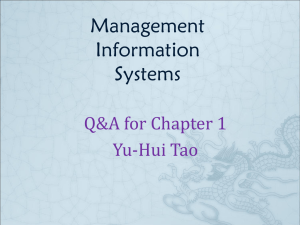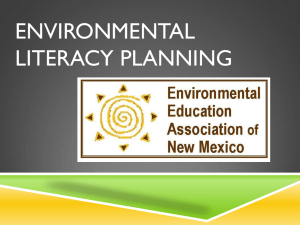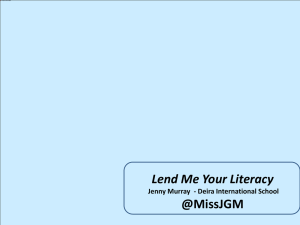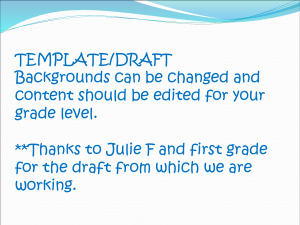The Case for Service Learning
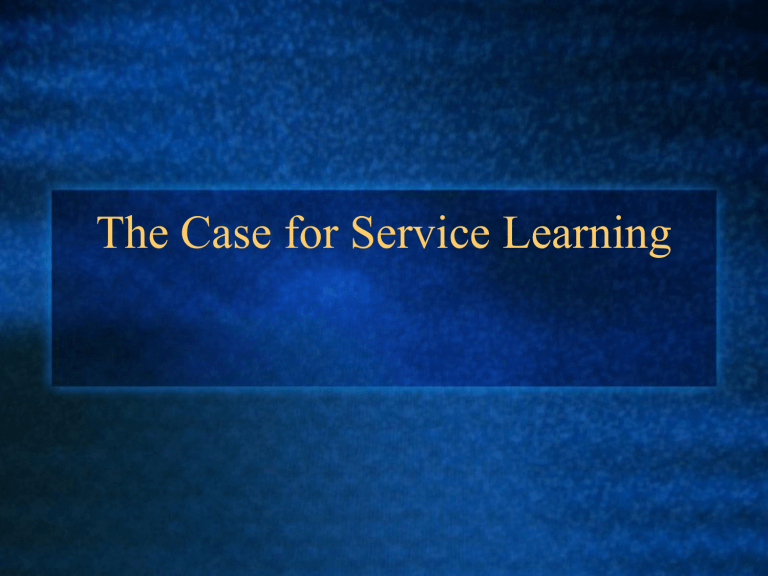
The Case for Service Learning
Facts about student engagement in school in the U.S.
(Steinberg, 1996)
Over one third of students do not take school seriously and get through the day by fooling around with classmates
Half said their classes were boring
Two-thirds say they cheated on a school test
90% copied homework from someone else
80% say it is not important to get good grades in school
20% say they don’t try hard in school because they are worried about what their friends might think
20% say disengagement is a result of confusion or difficulty of subject matter, particularly in math and science
Engagement Research
Ames (1992), Strong, et al. (1995) and Anderman &
Midgley, (1998) show that teachers who are most successful in engaging students develop activities that address intellectual and psychological needs, including work that:
Develops their sense of competency
Encourages self-expression and originality
Allows them to develop connections with others
Gives them some degree of autonomy
Engagement Research, cntd.
Other researchers recommend:
Ensure course materials relate to students’ lives and highlight ways learning can be applied in real-life contexts
Allow students to have some degree of control over their learning
Assign challenging achievable tasks
Stimulate student curiosity about the topic
Design projects that allow students to share new knowledge with others
Develop caring and trust between teachers and students
Service Learning is a Promising Practice for
Engaging Students!
What is it?
A way of teaching & learning that connects meaningful service to the community with classroom instruction
Why is it useful?
It supports the best practice recommendations of the experts for engaging students in their learning.
To engage students, Service
Learning must be done well!
Research shows repeatedly that without high quality, there is limited benefit to students.
Service-Learning Components
INVESTIGATING a community issue through research and community needs assessment
PLANNING the ways students will address the issue
ACTION--performing the service activity
REFLECTION--thinking about the impact on others and self, what worked and what did not, and the relationship of oneself to the world
DEMONSTRATION--showing the impact of the project on self and others (especially to an authority figure)
CELEBRATION of the impact
Support Our Troops Example in
Chassell
INVESTIGATE
Guest speaker: the National Guard
Internet research: What do troops need?
What is already supplied?
Create a baseline: a needs statement that measures the current situation
PREPARE
What will the service be?
Who are my partners?
How will the kids contribute?
What skills will the kids need--academic and civic?
Do we need any “sensitivity” training?
What content info is relevant?
What are my learning goals?
ACTION
Writing poetry & letters
Working in a writing group for the writing process
Gathering & organizing donations
Promoting our project in the school & community
Packing the boxes
REFLECTION: done throughout!
Investigation: What did we learn from Mr.
Collins? How could we help him?
Preparation: What is a free verse poem?
What is a metaphor? What are the features of a personal letter? What do we need to be sensitive about? Is my writing effective and vivid?
Action: How could we organize our donations? How can we promote our project in the school & community?
DEMONSTRATION / CELEBRATION
Viewing photos together
Enjoying our voice thread with snacks
Designing a display case
Sharing about our project through a bulletin board near the gym
How does service learning connect to the common core standards?
Examining the connection to English
Language Arts &
Literacy in History/Social Studies,
Science, and Technical Subjects
What is embedded in the common core literacy standards that makes service learning a good vehicle for reaching them?
The heart of the standards:
Make sure students are college and career ready by the end of high school
Common Core Literacy Goals in general…
Create readers, writers, speakers, and listeners across content areas
Develop literacy as an integrated skill for all fields, including social studies & STEM
Provide students opportunities to conduct research and to produce and consume media in all content areas
Address college and career readiness skills through general, cross-disciplinary literacy expectations
Fact:
The New ELA Core Standards recognize that teachers in other content areas must have a role in helping students develop literacy skills.
The reality: students are not ready to encounter the complex informational text required in college or the workplace.
The new common core standards have a special emphasis on informational text and inter-disciplinary literacy.
…mastering literacy skills for common core standards
Is Service Learning the vehicle…
..to take us to our destination?
…being ready for the real world
Features of the Service Learning
Car…
Students are in the driver’s seat of their learning
Promotes career readiness and job skill identification through real world contexts
Provides an opportunity for curriculum integration across content areas
Fosters teamwork, leadership, mutual achievement, and social development
References
Billig, Shelly. RMC Research
Corporation, 2008.
Michigan Department of Education,
Common Core State Standards
Initiative, http://www.corestandards.org








